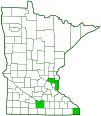anchor stink bug
(Stiretrus anchorago)
Conservation • Description • Habitat • Ecology • Distribution • Taxonomy
|
|
||||||||||||||
Description |
Anchor stink bug is a colorful, medium-sized but robust, predatory stink bug. It is common in the eastern half of the United States, in Mexico, and in Central America. It is rare in Minnesota, where it is at the northern and western extents of its range. Anchor stink bugs are highly variable in both color and markings, leading one entomologist to suggest, “In identifying asopines it helps to be color blind.” Several subspecies have been described, five of which occur in North America. The northern subspecies, Stiretrus anchorago anchorago, occurs in Minnesota and is described here. Adults are 5 ⁄16″ to 7 ⁄16″ (8 to 11 mm) long and ¼″ wide. The body is egg-shaped when viewed from above, widest in front and gradually narrowing toward the rear, and convex when viewed from the side. The head is bluish-black and coarsely punctured. The sides of the head are nearly parallel. There are two large, bulging compound eyes and two simple eyes (ocelli). The ocelli are orange. There is a small orange spot near the middle of the rear margin (middorsal) that appears to be, but is not, a third ocellus. The front of the head is divided into a central lobe (tylus) and two lateral lobes (juga). The juga are a little longer than tylus. The beak-like projection of the head (rostrum) is long, very thick, and has four segments. The first segment is thickened and free, enabling it to be swung fully forward. The second segment is longer than the third. At the base of the rostrum there is a pair of raised plates (buccula). The bucculae are very short and cover only the base of the first segment of the rostrum. The antennae are brownish-orange and have five segments. The basal segment is very short, not reaching beyond the front of the head. All segments are densely covered with fine hairs. The thorax is twice as wide as long. The exoskeletal plate covering the thorax (pronotum) is bluish-black and coarsely and irregularly pitted. It projects outward with a broadly rounded point in the shoulder (humeral) areas. The humeral areas are cream-colored. They are flushed with red, have two or three round black spots, and numerous black punctures. There are two pairs of wings, and they are held flat over the body when at rest. Between and at the wing bases there is a triangular plate (scutellum). The forewings (hemelytra) are as long as the abdomen but do not completely cover the sides of the abdomen. The sides of the abdomen are exposed. They are cream-colored, flushed with red, with black spots. They appear conspicuously striped when the wings are closed. The hemelytra have a thickened, leathery section at the base and a thin membranous section at the tip with a clear dividing line between the two. The thickened basal part is comprised of a narrow area (clavus) behind the scutellum when the wings are closed, and the remaining broad marginal area (corium). The scutellum, the most distinguishing feature of this species, is very long and broad. The basal portion of the scutellum is broadly triangular. It is cream-colored and may be flushed with red on the sides, and has a large black spot in the middle. The lower portion is U-shaped and extends nearly to the tip of the abdomen. It is cream-colored and flushed with red, sometimes appearing mostly red. A pair of median, elongated, black spots are joined at the base an separated toward the tip. Joined with the spot on the basal portion of the scutellum, this forms a single, black, anchor-shaped spot, for which this species gets its common name. The clavus and corium are cream-colored and flushed with red, sometimes appearing mostly red. There is an irregular dark spot near the middle or toward the tip of each corium. The hindwings are thin, membranous, and concealed under the forewings. The legs are brownish-orange. On the front legs the third segment (femur) has a blunt spine near the tip, and the fourth segment (tibia) is distinctly dilated. On the hind legs the fourth segment has a small spine on the inner surface. The end part of the leg, corresponding to the foot, (tarsus) has only 3 segments. |
Size |
Total length: 5 ⁄16″ to 7 ⁄16″ |
Similar Species |
Habitat |
Old fields, agricultural fields, and other open areas |
Ecology |
Season |
Two generations: April to October |
Behavior |
They emit a musty odor when handled. |
Life Cycle |
The last generation of adults overwinter in a state of suspended development (diapause). In the spring, the female lays a double row of usually about 12 oval, nearly black eggs. The eggs hatch in 8 to 11 days, and the larvae reach adult stage in 21 to 44 days. |
Nymph Food |
|
Adult Food |
Beetle, moth, and butterfly larvae |
Distribution |
||
|
Sources |
|
| 11/10/2024 | ||
Occurrence |
||
Common in eastern United States, rare in Minnesota. |
||
Taxonomy |
|
Order |
Hemiptera (True bugs, Hoppers, Aphids, and Allies) |
Suborder |
Heteroptera (True Bugs) |
Infraorder |
Pentatomomorpha |
Superfamily |
Pentatomoidea (stink bugs, shield bugs, and allies) |
Family |
|
Subfamily |
Asopinae (predatory stink bugs) |
Genus |
Stiretrus |
Subgenus |
Stiretrus |
Subordinate Taxa |
|
Stiretrus anchorago anchorago (mostly northern subspecies) Stiretrus anchorago diana Stiretrus anchorago fimbriatus (mostly southern subspecies) Stiretrus anchorago personatus (red pronotum) Stiretrus anchorago violaceus (Pennsylvania and possibly Illinois; deep violet-black) |
|
Synonyms |
|
Cimex anchorago Pentatoma pulchellus Stiretrus fimbriatus Tetyra anchorago |
|
Common Names |
|
anchor stink bug |
|
Glossary
Femur
On insects and arachnids, the third, largest, most robust segment of the leg, coming immediately before the tibia. On humans, the thigh bone.
Hemelytron
The forewing of true bugs (order Hemiptera), thickened at the base and membranous at the tip. Plural: hemelytra.
Ocellus
Simple eye; an eye with a single lens. Plural: ocelli.
Pronotum
The exoskeletal plate on the upper side of the first segment of the thorax of an insect.
Rostrum
The stiff, beak-like projection of the carapace or prolongation of the head of an insect, crustacean, or cetacean.
Scutellum
The exoskeletal plate covering the rearward (posterior) part of the middle segment of the thorax in some insects. In Coleoptera, Hemiptera, and Homoptera, the dorsal, often triangular plate behind the pronotum and between the bases of the front wings. In Diptera, the exoskeletal plate between the abdomen and the thorax.
Tarsus
On insects, the last two to five subdivisions of the leg, attached to the tibia; the foot. On spiders, the last segment of the leg. Plural: tarsi.
Tibia
The fourth segment of an insect leg, after the femur and before the tarsus (foot). The fifth segment of a spider leg or palp. Plural: tibiae.
Visitor Photos |
||
Share your photo of this insect. |
||
This button not working for you? |
||
Alfredo Colon |
||
 |
||
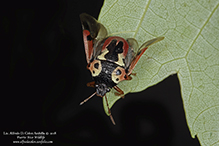 |
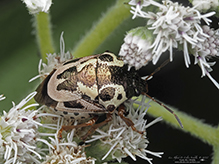 |
|
Greg Watson |
||
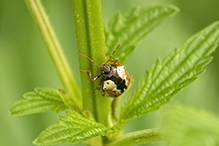 |
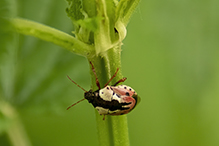 |
|
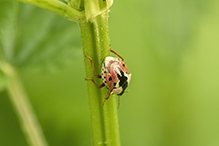 |
||
MinnesotaSeasons.com Photos |
||
|
||
|

Slideshows |
|

Visitor Videos |
||
Share your video of this insect. |
||
This button not working for you? |
||
|
Other Videos |
||
|

Visitor Sightings |
||
Report a sighting of this insect. |
||
This button not working for you? |
||
Alfredo Colon |
Location: Albany, NY |
 |
| Alfredo Colon 8/5/2022 |
Location: Albany, NY |
 |
| Greg Watson 6/12/2022 |
Location: Wagon Wheel Trail, La Crescent, MN |
 |
| Alfredo Colon 7/13/2018 |
Location: Woodbury, Minnesota |
 |
MinnesotaSeasons.com Sightings |
||
|

Created: 1/14/2019 Last Updated: © MinnesotaSeasons.com. All rights reserved. |
